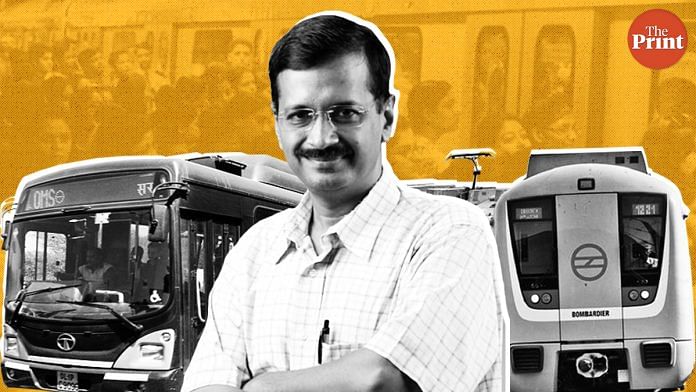Delhi chief minister Arvind Kejriwal Monday announced free public transport for women, which includes rides on Delhi Metro, DTC and cluster buses. Kejriwal said the move is aimed at ensuring “safety of women”.
ThePrint asks: Kejriwal’s safety plan: Should Delhi women get special treatment with free public transport?
Hope Kejriwal govt gives more thought to women empowerment and safety
 Sheila Dikshit
Sheila Dikshit
Former Delhi CM and president, Congress Delhi unit
While Arvind Kejriwal has gone ahead and announced free rides for women in Delhi Metro and DTC buses, one isn’t quite sure about the implementation.
The operational details aren’t clear and we don’t know how it will pan out. More importantly, we do not know what such a move will cost the Delhi government, even if the government claims it will be Rs 700 crore this year. Can the government afford such a measure? Some important decision will have to suffer on account of this expenditure.
I don’t quite understand why this move has been initiated, and what’s the rationale behind it. Let us see how it helps everyone. If they say this is to meant to ensure safety of women in Delhi, then all I can say is that it is kind of them to think of women’s issues. But, I do really hope they would give more thought to women empowerment and safety. They can do so much more than just this.
One will have to wait and see what the whole plan is, and how they will go about ensuring its smooth implementation.
Women suffered the most because of Delhi Metro fare hike — this move will make amends
 Akshay Marathe
Akshay Marathe
Spokesperson, Aam Aadmi Party
The Delhi Metro fare hike last year led to 3 lakh less daily riders on the metro. Riders decreased from 28 lakh in March 2017 to 25 lakh today.
When the central government, as well as the Delhi government, pumped in crores of rupees into the Metro, the estimated daily average ridership capacity in mind was 40 lakhs. But this isn’t the case, because people of Delhi don’t find taking the metro financially feasible anymore.
Even among the people who find it difficult to use the Metro as a mode of daily transport, it is the women who are the worst hit. An average of 33 per cent women use the Metro, making it clear that women who have suffered the most due to this fare hike. As a result, they were forced to use alternate modes of transportation, which aren’t entirely safe.
Around the world, a country’s public transport is seen as the safest option, and there should be no reason for women to be opting for other modes of transport especially if there is enough capacity in our Metros. Women feel safer around other women in public transport, as they know they will come to their rescue if needed.
This move will help women reclaim public spaces so that they feel safer, while also incentivising them to travel to work.
As far as operational details are concerned, we will work out a model that is easy and feasible for everyone. The Delhi Metro will continue to get the revenues, as it should. The Delhi government will pay and reimburse the Metro for the free travel of women.
Also read: AAP vows quota for Delhi residents: Justified or turning Delhi into a parochial city?
Free rides alone can’t ensure women’s safety; will need to be backed by other policies
 Jayashree Velankar
Jayashree Velankar
Director, Jagori
While we acknowledge that this move may encourage women’s mobility and benefit those women from poorer sections, we want to state that free rides alone can’t ensure safety for women riders and women in general. When streets are populated by a greater number of women then it will create pressure on authorities to enhance systems for women’s safety.
Our long-standing demand for women’s safety makes clear the fact that safe and gender-inclusive public spaces for women and girls will be an outcome of multiple concerted policies and programmes including public awareness. Specifically, the following factors need to be kept in mind – provision of gender-sensitive urban infrastructure, sensitive policing, prompt action against perpetrators/harassers and an end to the culture of impunity. These factors will cumulatively over a period lead to sustainable solutions for ensuring women’s safety.
How is free travel supposed to benefit women’s security?
 Sudhanshu Mittal
Sudhanshu Mittal
Spokesperson, BJP
This freebie announcement is a desperate move by the Delhi government to garner votes. Arvind Kejriwal has made several such promises in the past including free wifi and installation of CCTV– but none have been implemented. As the saying goes, “you can fool some people all the time, and all the people some time, but you cannot fool all the people all the time”. But Kejriwal thinks he can.
He had also promised to make 35,000 additional beds in hospitals, but how many of those have been created? Besides this, what is the progress on the schools and universities he had vowed to build in Delhi? When nothing worked, he went ahead and promised reservations for Delhiites in Delhi colleges. What prevents him from fulfilling all these promises?
It’s tough to take Arvind Kejriwal’s announcements seriously, because he lacks intention and integrity. He has low credibility and is bound to make such gimmicky announcements.
We need to ask ourselves, how is free travel supposed to benefit women’s security? It may help them economically, but how does it contribute to enhancing their safety? Arvind Kejriwal’s decisions aren’t necessarily backed by logic, as is the case this time.
Also read: Is AAP’s Arvind Kejriwal also guilty of treating Muslims as an unthinking votebank?
Resources like free and safe transport can help fight family’s resistance to women’s ambitions
 Fatima Khan
Fatima Khan
Journalist, ThePrint
When a woman sees other women occupying a public space, it suddenly becomes more inviting and comforting. This is why women tend to naturally gravitate towards the female coach in the Metro. It isn’t surprising that men simply don’t get it – they have never had to think twice before entering a room filled to the brim by women.
Arvind Kejriwal’s new plan to make Delhi Metro and DTC bus rides free for women is a welcome move. Sure, men from economically weaker sections also suffered when the Metro rates were hiked substantially last year, but it is a well-established fact that it is the women in the family who are hit the hardest whenever there is a family budget cut. For working women and students, safe, accessible and economic modes of transport are a boon. Not only do they stand to gain the obvious benefits, but having such resources can also help fight family’s resistance to their ambitions.
Of course, the AAP government has to straighten out the operational details. How will this system practically play out? More importantly, they claim it’s from the Delhi taxpayers’ money – but what about NCR residents who board from Gurgaon, Ghaziabad and Noida? They aren’t Delhi’s tax paying residents. This could potentially poke holes in the party’s repeated flawed attempts at dividing a city as heterogeneous as Delhi on the basis of taxpayers and non-taxpayers.
By Fatima Khan, journalist at ThePrint.




“you can fool some people all the time, and all the people some time, but you cannot fool all the people all the time” ??? An idiotic response, indeed.
What about transgenders? No Free rides for them? Sexist Kejriwal murdabad.
The objective of making women’s rides free is to encourage them to take up more public space; more women means they’ll feel more secure. So it’s a good move. But each service has a cost and who’ll bear the cost in this case. The taxpayers! Why? Almost all the rides of the babies and kids are free today, that of the children and senior citizens are subsidized. So why can’t the women’s rides be subsidized? There is another argument against making it a freebie; anything available for free tend to be misutilized. What if a woman simply travels to spend time? If a woman’s travels are free and that of children are not free, should the woman stand in queue to buy ticket for the children? Doesn’t it look odd? It’s like, helmets are not made mandatory for SARDARs, so it looks odd to make helmet mandatory for their women who are pillion riders. In fact the mandatory rule for wearing of helmets for pillion riders was revoked in Delhi at least once only for this reason.
Anything that empowers women gets my vote. However, with the caveat that it should be fiscally sustainable. Delhi Metro is not financially profitable, despite so much support, starting with low cost funding from Japan. In Bombay, the BEST’s bus service loses money, subsidised by the supply of power. It will be difficult to extend public transport – environmentally an imperative – if its viability is further eroded by such clearly We have to win the next election at all costs populism. Even AAP’s decision to supply free water to households is not prudent. AK will have to learn from LKY if Delhi is to become Singapore.